This equine enrichment activity is so simple, but offers your horse a great novel experience and the opportunity to browse for overhead food. And you can set it up in 5 minutes!
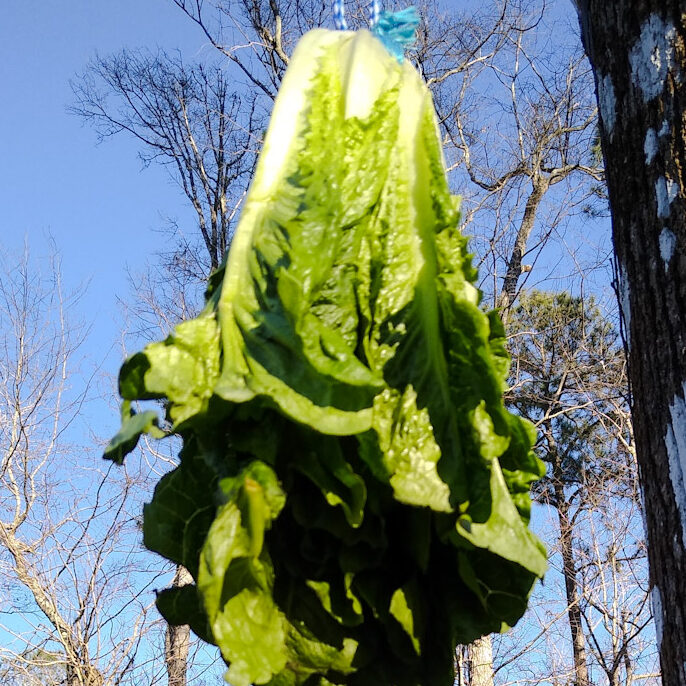
What Is It?
A whole head of romaine, secured upside down with bailing twine from a sturdy overhead object such as a tree branch.
The Behaviors
Browsing
Tools and Supplies
- One head of romaine or leaf lettuce (romaine is best because of its sturdy core)
- One 3-foot of baling twine or other sturdy twine
- Stainless steel darning needles
- Rope with clips for securing overhead (optional, but makes any hanging enrichment items much easier to set up)
Why It Works
Versatile Setup
A lot of the enrichment activities that encourage browsing, like providing cut branches from edible trees, can’t be prepared in your home. This enrichment can, so it’s great for bad weather days or when you just want to throw something together quickly indoors before transferring it out into the pasture or stall. You can use this enrichment in any location, from outdoors in the pasture or paddock to the horse’s stall or even the barn aisle (you’ll need a ladder to do that one).
Great for special needs
I like that this enrichment activity offers a chance for browsing behavior using food material that is really low calorie and low sugar, so it’s appropriate for use with metabolically sensitive horses. Also, lettuce leaves are soft, so even horses with compromised chewing ability should be able to participate – unlike browsing from twiggy shrubs or branches, which horses with poor teeth may no longer be able to do.
Budget friendly
Third thing to love about Lettuce Browse is that it’s really budget-friendly! Including lettuce, tie line, and clip, this enrichment cost less than $5. Once you have your tie line made, or if you use baling twine instead, you will have a browsing enrichment item that costs less than two bucks each time you want to offer it. That’s budget-friendly enough for any equestrian.
The benefits of lower-value resources
The last thing I like about this enrichment is that some horses simply won’t be immensely interested in it. Why might this be a good thing? Don’t we want enrichment to be immediately attractive to horses and keep them busy and engaged?
Yes…and no. When we set up enrichment activities for our horses, we should do it to encourage natural behaviors. Horses in a wild state might not browse one tree or bush continuously until they’ve stripped it of all edible forage – in fact they are probably unlikely to do this. They’re more likely to take a few bites, move on to another desirable source of food, and possibly repeat until the food is gone or they’re ready to leave the area.
When you offer a highly palatable or engaging food as an enrichment situation, the horse is probably going to engage with it until they are sure they have taken every last morsel of the resource on offer. This is a natural behavior too, because highly palatable resources are desirable enough to consume all at once and make sure that nothing is left behind.
Lettuce isn’t particularly sweet, and some horses enjoy it more than others – some don’t care much for it at all. In this context, it is a low-value resource. The horse may initially investigate, perhaps take a sample bite or two, and then choose whether they want to continue interacting with the hanging lettuce head. If the taste isn’t worth it, they’ll walk away and do something else.. but a few minutes or even hours later they’ll probably come back to it again for another sample. Rinse and repeat – sometimes over the course of a whole day – until eventually the lettuce is gone.
In this way, you’ve given the horse the opportunity to express a slightly different set of natural behaviors beyond simply feeding by browsing plant material high off the ground: choosing freely between different options in their environment.
The Setup
For this enrichment, you’ll start by making the tie lines you’ll use to hang the lettuce securely from an overhead item. Then you’ll thread the lettuce onto a sturdy double loop of baling twine before heading out to hang it up for your horse to enjoy. I’ve included step by step photos of all the loops, knots, and other techniques used to make this enrichment safe and effective.
Why All the Details?
Why spend more time talking about lines and knots than about giving the enrichment itself?
Because making the lettuce browser isn’t difficult or time-consuming, but your results will be better if you pay attention to your setup technique and have the right tools and materials. Being picky about how you create this enrichment has three benefits:
- Using a needle allows you to double up your baling twine and pass the line through the lettuce core rather than the leaves, so the lettuce head won’t strip away from the line and fall to the ground. The browsing opportunity is available to the horse for much longer this way.
- Sticking twine through the needle and tying the lettuce up is extremely quick – it’s extra efficient, which translates into less time prepping enrichment and more time giving it to your horse.
- There are no loose ends, loops, or weak knots that can come undone or create a hazard as the horse browses.
Now let’s get to the details!
First make your tie line, if using. And I definitely recommend making a couple of tie lines for use with this and other enrichment items.
A tie line complete with clips means that you don’t have to tie knots each time you want to hang up an enrichment item. It’s great for hanging smear boards, webby balls, and other free-swinging enrichment. Most importantly, it is sturdier and thus safer than knotting or looping up twine each time you want to give your horse hanging enrichment – bad loops and insecure knots can create safety hazards, which is the last thing you want when putting together enrichment! Once you have them, you can reuse them again and again.
You can use baling twine, but for increased strength and durability I recommend a length of polypropylene, nylon, or other sturdy rope. By knotting a tie line with clips, it will be faster and easier to hang up the lettuce, you’ll have more options for location, and you’ll have access to this rather than having to install and tie a full string to hang the lettuce every single time.. more on that below.
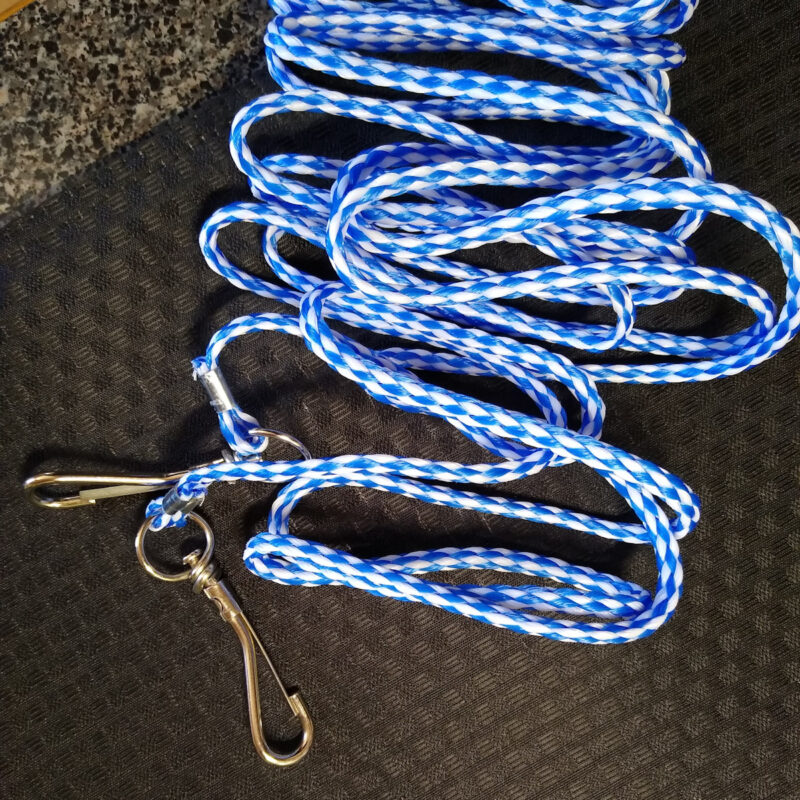
This is a polypropylene tie out cord for dogs. I found it locally but you can get one from Amazon – this one has bullnose clips, which make hanging the lettuce a breeze. These lines come with a clip on both ends, which is an extra plus – you can create two tie lines without the need for any additional clips or carabiners.
A 15 ft line is shown, and that’s enough to make at least two ties, and three or more if you want shorter lengths. Here, I kept them long for more options down the road, but had to double them up to hang the lettuce head. For most situations I would recommend cutting a line this size into 5-foot lengths.
Make your knot: a figure 8 on a bight, as shown. Not good with knots? I’m not either, so hopefully these step-by-step photos help. This knot is very simple and is basically just doubling the rope on itself (forming a protruding loop called a bight), then tightening up the resulting knot.
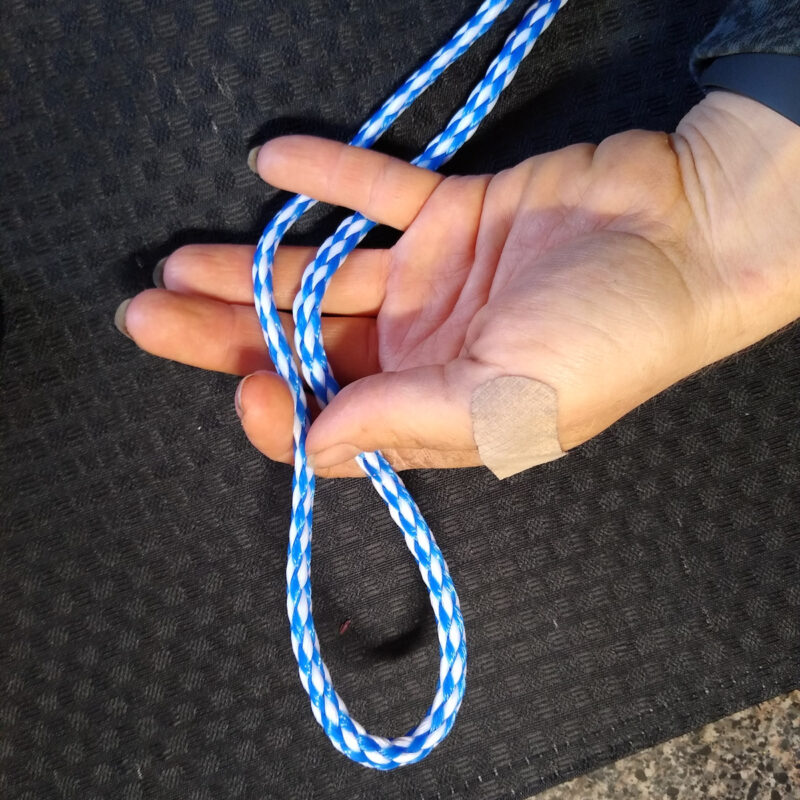
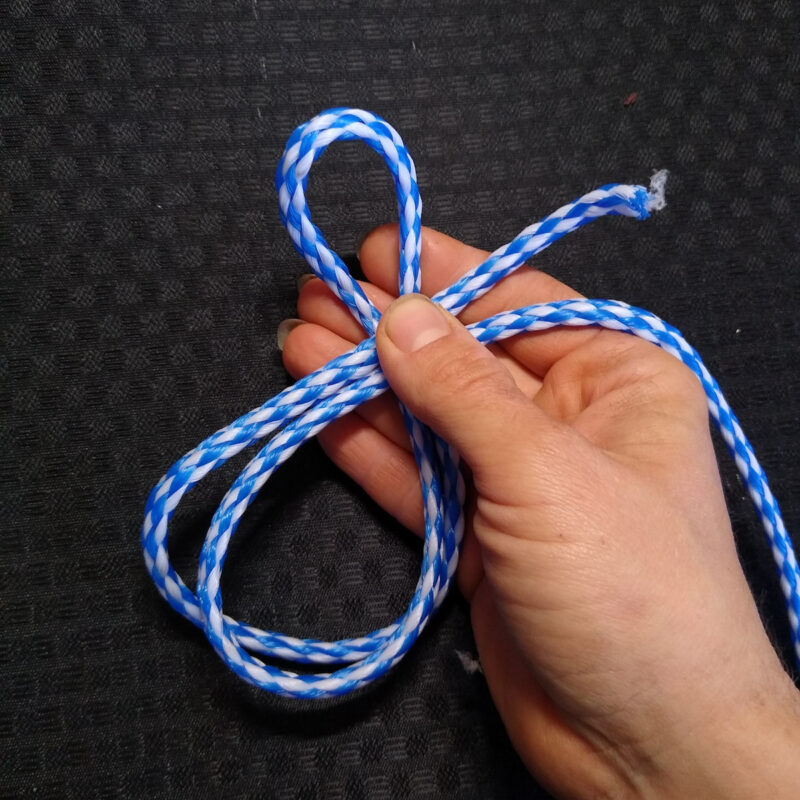
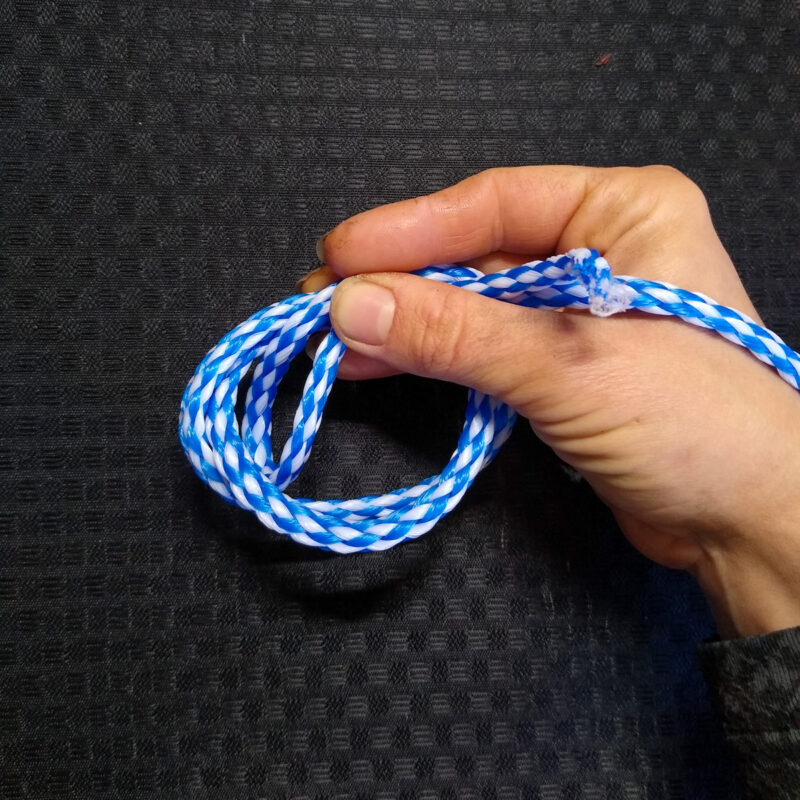
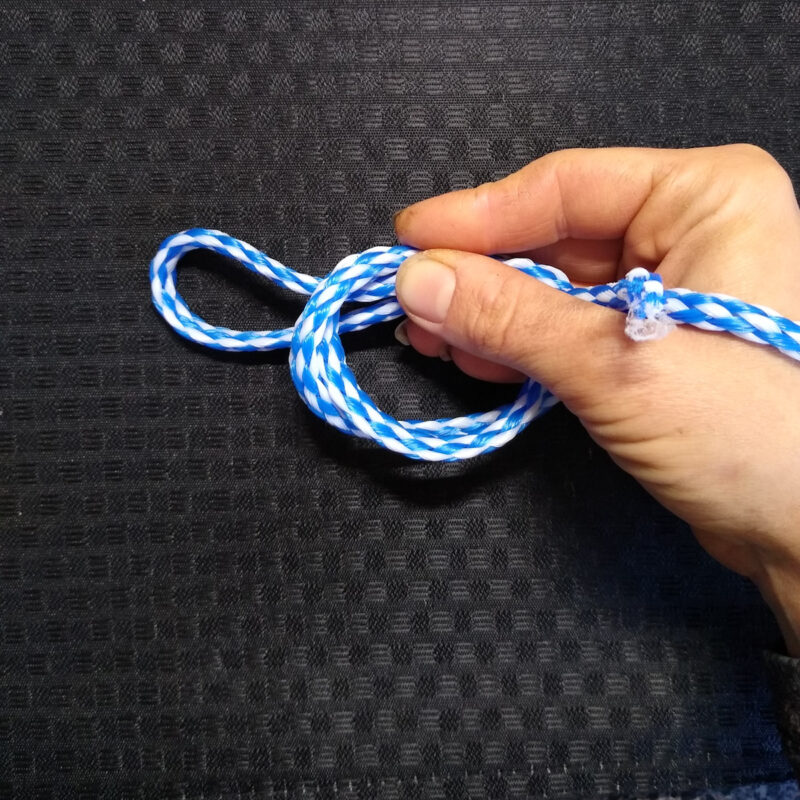
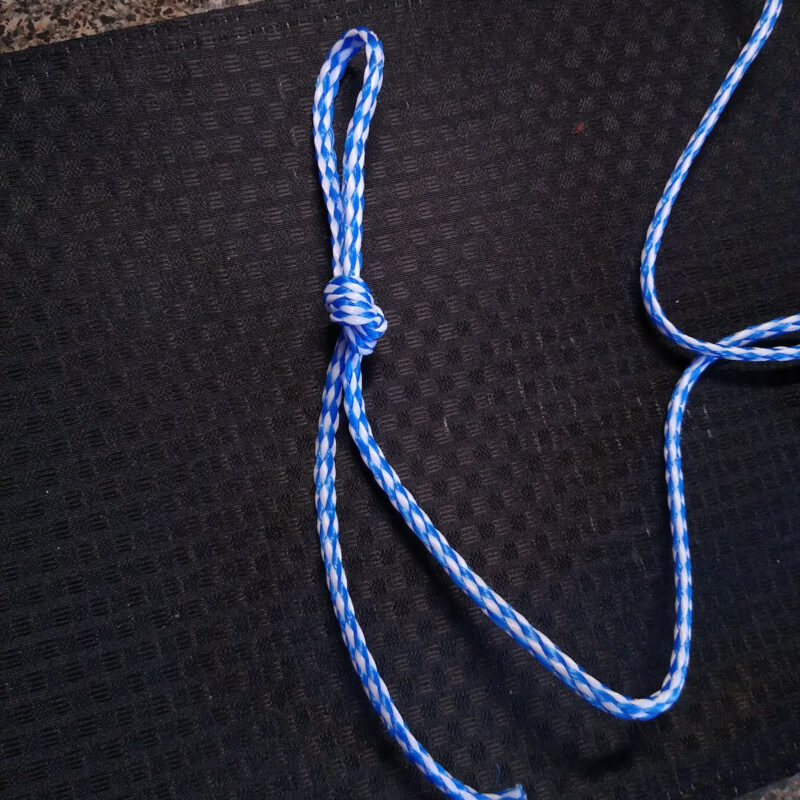
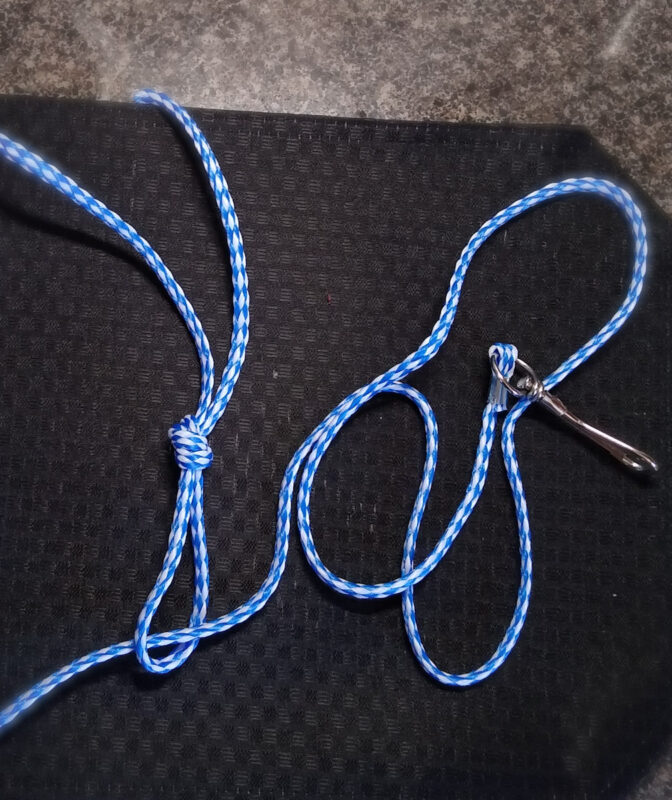
Next, prepare your length of baling twine. You can use other twines as long as they fit into the eyes of your needle, but baling twine is very strong, readily available, and easy to work with. It threads through the needle like a charm, which is why I use it here.
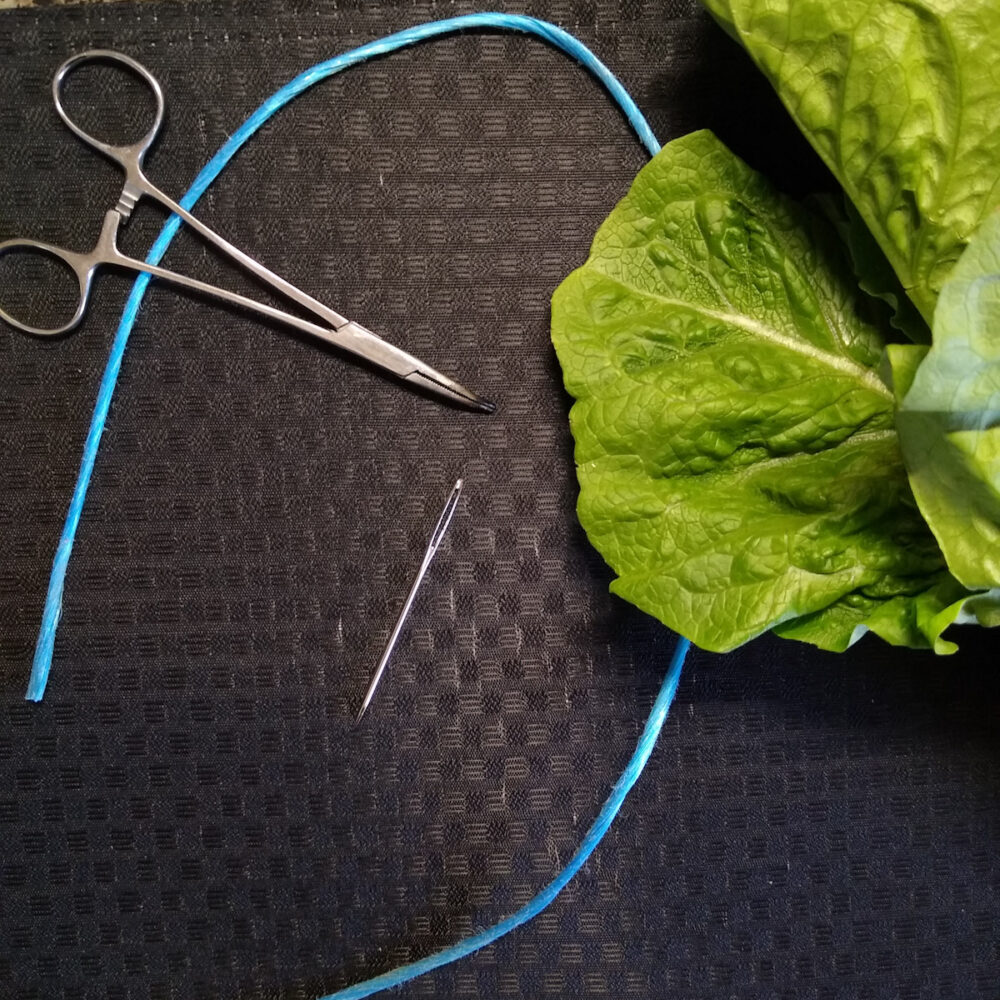
Cut at least a 3 ft length of baling twine. You can always cut the excess off later, but it’s a huge pain to make knots with twine that is too short, and the knots are never as strong. You need that extra length to really pull them tight.
Thread one end of the twine through your darning needle, as shown. I use these stainless steel darning needles from Amazon. They were very inexpensive and have nice big eyes that are easy to thread. Plus they’re strong and sharp enough to get through all kinds of stuff…like romaine cores.
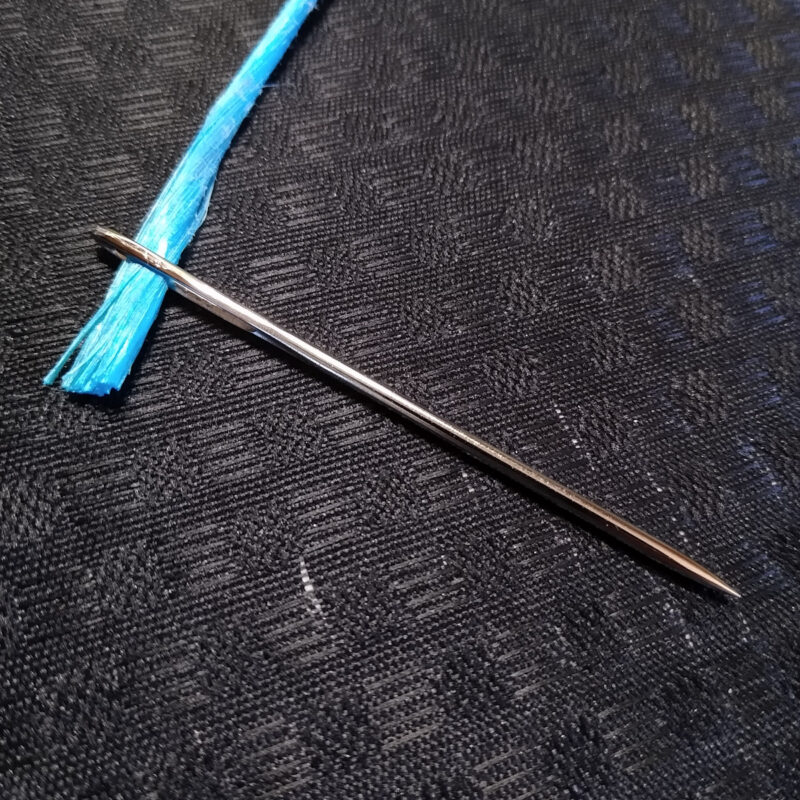
Pull the ends level and you’ll have about a foot to a foot and a half of doubled twine. Knot the ends:
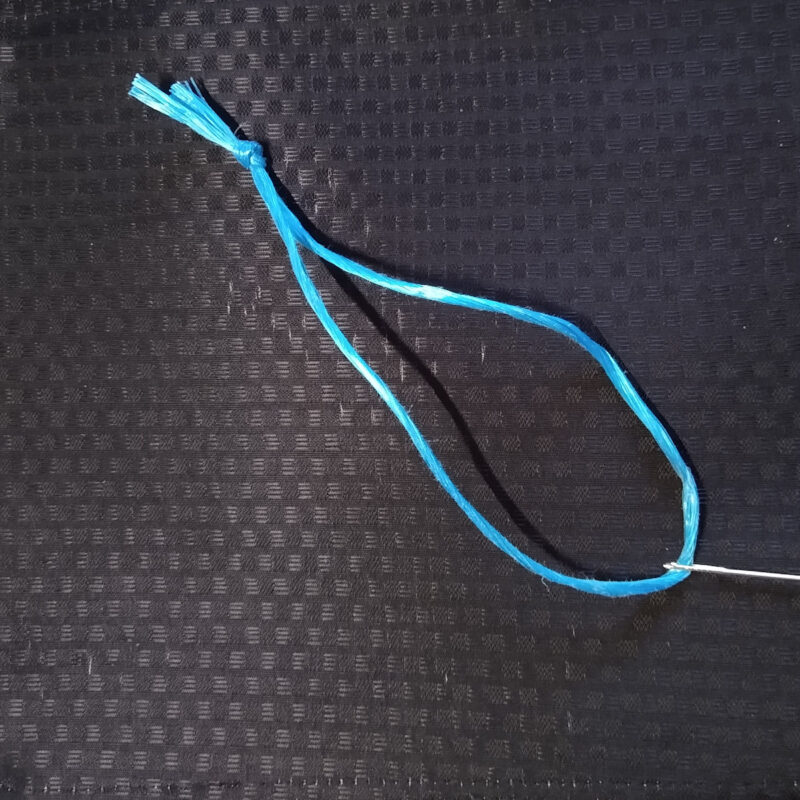
Now grab your head of lettuce. You’ll want a nice big mature head, with a thick sturdy core. The thicker and firmer the core of the lettuce, the less likely the lettuce is to tear off completely as the horse browses.
Carefully but firmly push the needle through the lettuce. If necessary, pull it through using hemostats or pliers when if emerges through the other side:

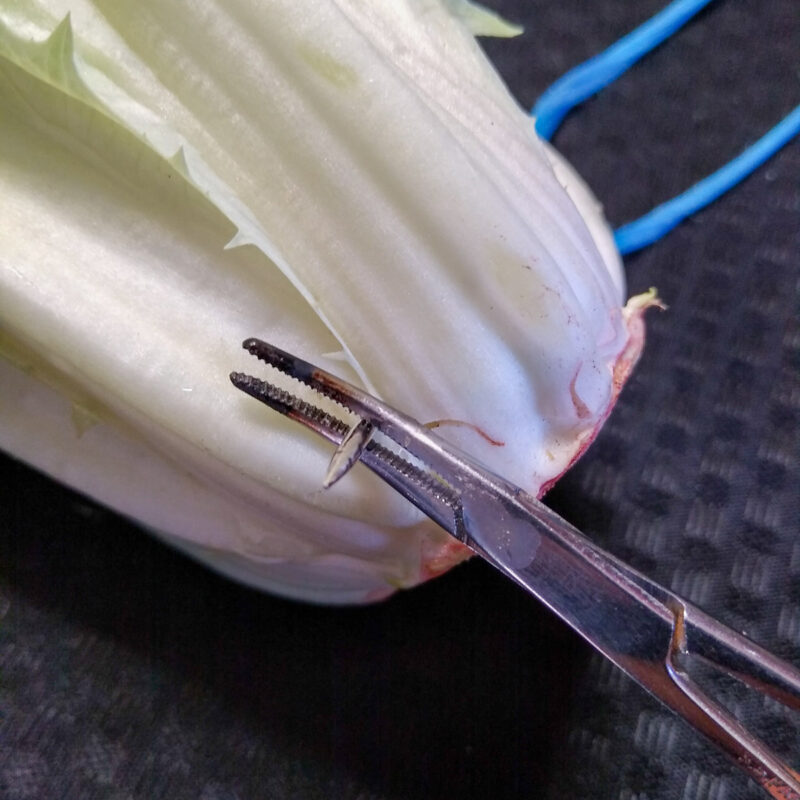
Now knot the twine securely, pulling it somewhat snug around the lettuce:
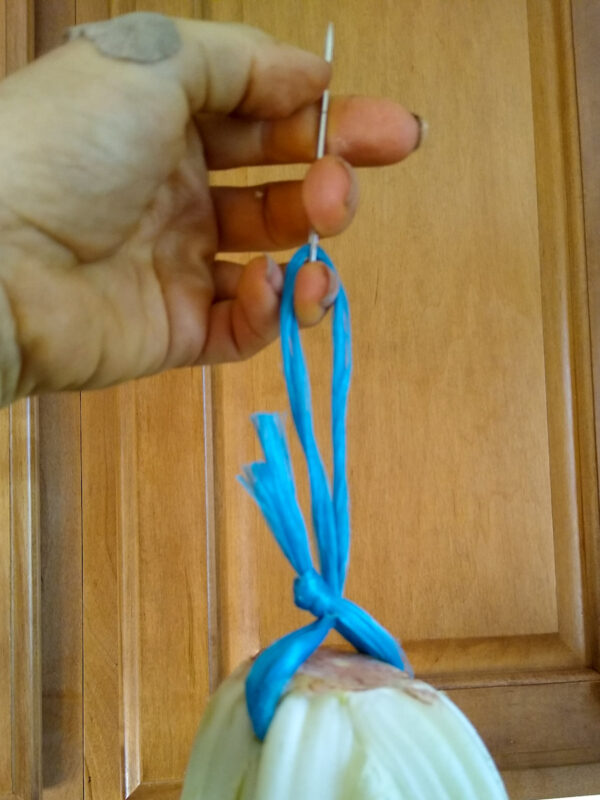
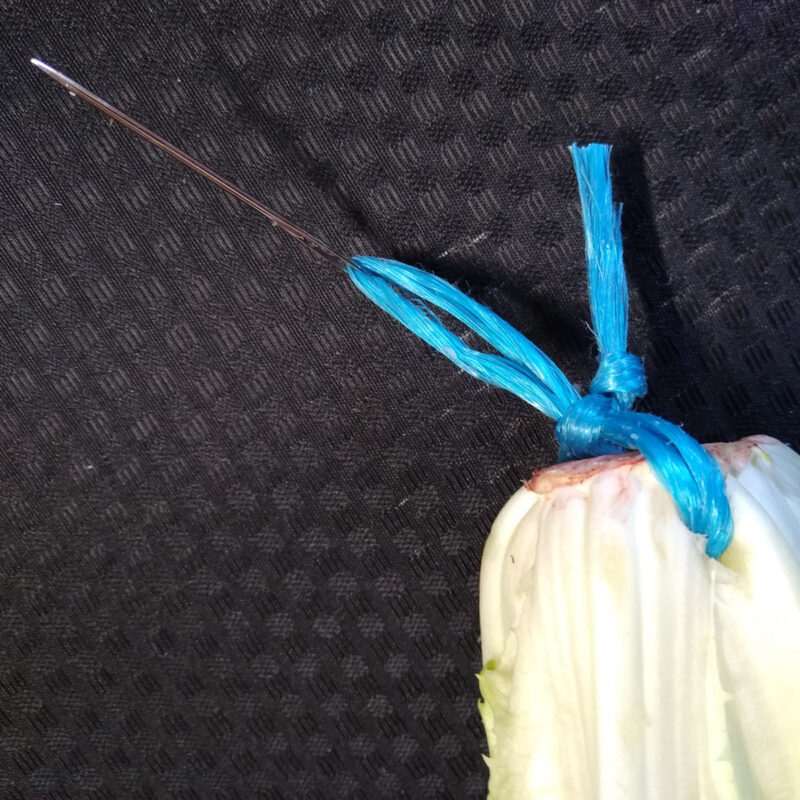
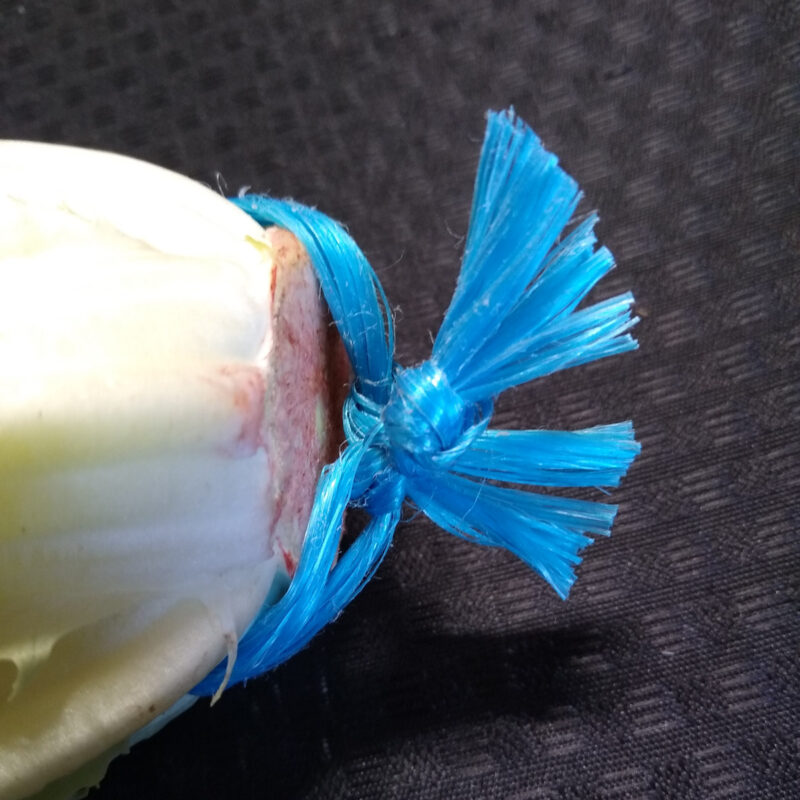
You can see how the doubled twine is stronger and will support the weight of the lettuce more than a single strand.
Now head out to the pasture or stall to hang your lettuce!

If you’re using a tie line, hanging up the lettuce with be a cinch. Clip one end to the loop you threaded into the lettuce core. Loop the other end over a limb or rafter and secure the line.
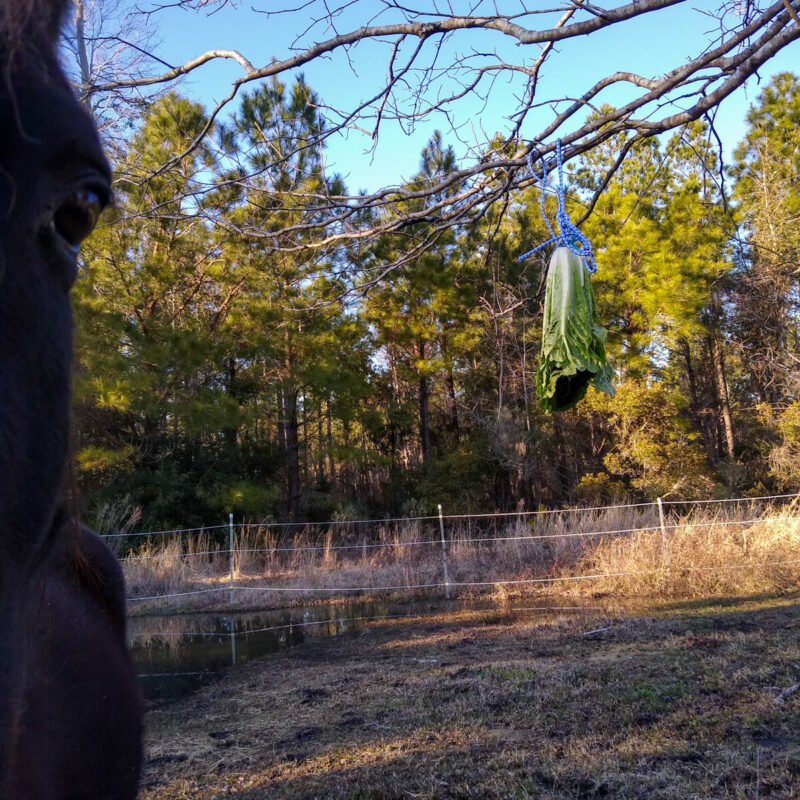
Remember to let your horse interact or avoid the object as they choose. Some horses may be nervous of the hanging lettuce, especially if there’s a breeze causing it to move. With time and repeatedly offering the enrichment, curiosity should win out and you might observe the target behavior, browsing. If so, add hanging lettuce to your regular rotation to give your horse a great opportunity for a natural behavior.
Safety Notes
All diet items should be introduced slowly. If your horse is new to leafy greens, offer some pieces for a few days before giving an entire head.
This enrichment should be hung up at or above the height of the withers, and there shouldn’t be any loops of rope that could cause entanglement.
The first few offerings should be supervised to monitor your horse and ensure that they interact reasonably and safely with the lettuce browser.
Have you given your horse a hanging lettuce or other browsing enrichment? Tell us about it with a comment!
Pingback: Things on Strings: DIY Hanging Treat Toy - Enriching Equines